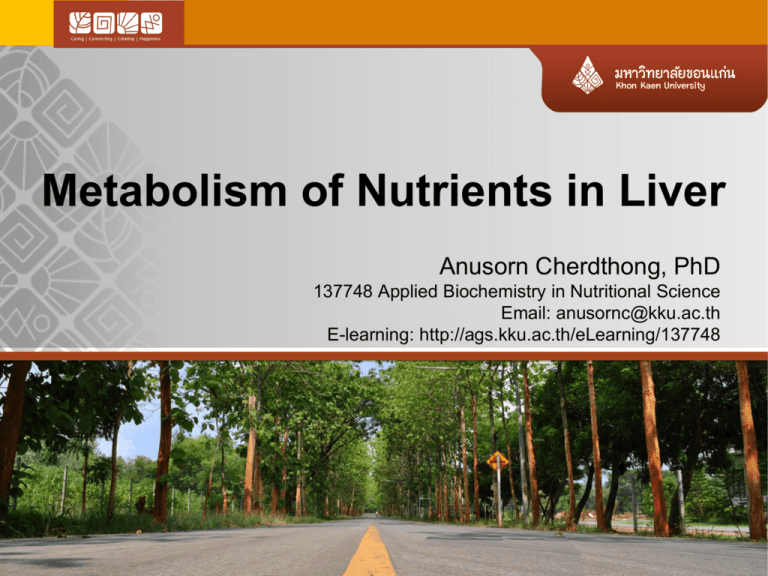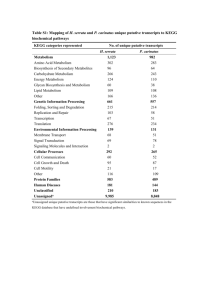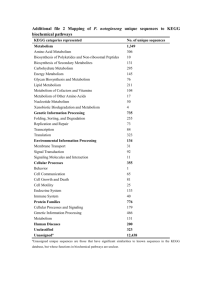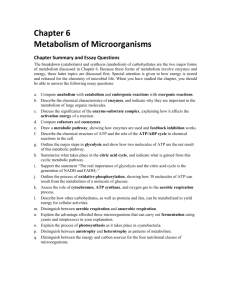Chapter 8
advertisement

Metabolism of Nutrients in Liver Anusorn Cherdthong, PhD 137748 Applied Biochemistry in Nutritional Science Email: anusornc@kku.ac.th E-learning: http://ags.kku.ac.th/eLearning/137748 Introduction Role of liver: Biosynthesis Metabolic regulation Inactivation or detoxification Secretion Liver metabolism Ruminant Riis (1983) Liver metabolism Non-ruminant Riis (1983) Carbohydrate metabolism Major metabolism: Glycolysis Pentose phosphate pathway : PPP or hexose monophosphate shunt : HMS Gluconeogenesis Glycogenolysis Glycogenesis Glycolysis or Embden-Meyerhof Minus Pathway Consisted of 11 reaction Product: (1 glucose) Pyruvate 2 ATP McDonald et al. (2011) Krebs cycle Occurred at mitocondria Oxidation acetyl Co A—H2O, CO2 Consisted 9 reactions Product: 3 NADH 3, 1 FADH2 , 1GTP McDonald et al. (2011) Pentose phosphate pathway Occurred at cytosol Provided NADPH, ribose McDonald et al. (2011) Gluconeogenesis glucokinase Km 10 mM (nonruminant) Hexokinase KM 0.010.1 mM (ruminant) Substrate are glucogenic, amino acids, lactate, pyruvate, glycerol, propionate Consisted of 3 reaction McDonald et al. (2011) Gluconeogenesis Substrates McDonald et al. (2011) Carbohydrate metabolism Glycogenolysis Lysis of glycogen when needed Appeared in live and musle End products are lactate or pyruvate Required enzyme phosphorylase a Carbohydrate metabolism Glycogenesis synthesis of glycogen Occurred at liver and muscle Required enzyme glycogen synthetase Protein metabolism Major metabolism Amino acids degradation Amino synthesis Regulation of protein synthesis Protein degradation Protein metabolism Amino acids degradation AA was used for energy source End products are amino group and carbon skeleton Ex: alanine degradation Pyruvate, aspatice acid Oxaloacetate, glutamate -ketoglutarate 2 reactions are deamination, carbon skeletal pathway Utilization of C skeleton McDonald et al. (2011) McDonald et al. (2011) Urea cycle 1 urea/ 4 ATP Excrete via urine Protein metabolism Amino synthesis Biosynthesis of non-essential amino acids Required glutamate dehydrogenase NADP as Co A ATP Re-used ammonia for synthesis Consisted of oxidation and tranamination reaction Protein metabolism Regulation of protein synthesis Control by RNA content in muscle, ATP and initiation process Occurred ribosomes high synthesis rate when fasting Protein metabolism Protein degradation Enzymes: endoenzymes and exoenzymes Endoenzymes: cathepsins B and D—short chain polypeptide Exoenzymes---degrade polypeptide to AA Cathepsins B-- albumin, ribonuclease and cytochrome C Cathepsins D--- haemoglobin Aminopeptidease D and alanine aminopeptidases degrade peptide at Nterminal Lipid metabolism Major metabolism Lipolysis Glycerol lysis Fatty acid biosynthesis Biosynthesis of triacylglycerols Biosynthesis of cholesterol Biosynthesis of glycerol Ketone bodies Lipid metabolism Lipolysis Required glycerol 3-phosphate Major reaction is -oxidation Occurred in mitochondria Acyl Co A form Carnitine transfer Acyl Co A across inner mitochondreia and need Carnitine acyltransferase I Lipid metabolism Lipolysis -oxidation—degrade FA on C beta 4 step of -oxidation Dehydrogenation 1 Hydration Dehydrogenation 2 Thiolytic cleavage 2 atom C are end product Lipid metabolism Glycerol lysis For energy source Start from fructose-1,6 diphosphate— glycolysis—pyruvate—TCA 44 ATP/ 2 Glycerol Lipid metabolism Fatty acid biosynthesis Occurred when sufficient energy, high Acetyl CoA Require NADPH Store as tryacylglecerol Consisted 2 sinthesis systems De novo synthesis Saturated FA with more than 16 C Lipid metabolism Biosynthesis of triacylglycerols Occurred when more CHO Substrates are FA (Fatty acyl-Co A ) and glycerol (Glycerol-3-phosphate) Diacylglycerol-3-phosphate was found in reaction 1,2-Diacylglycerol +Fatty acyl-Co A = triacylglycerols Lipid metabolism Biosynthesis of cholesterol Normally found in Liver LDL carrier cholesterol to other organs 3 step of biosynthesis: Synthesis mevalonate from acetyl Co A Synthesis squalene from mevalonate Synthesis cholesterol from squalene Lipid metabolism Biosynthesis of glycerol Synthesis from glucose via glycolysis Start with dihydroxyacetone phosphate--glyceral- 3 –phosphate--- phospho diglyceride--- diacylglycerol--triacylglycerol Lipid metabolism Ketone bodies Occurred when starvation Namely: Acetone, acetoacetate and D-hydroxybutyrate Ketone bodies were transfer to organ for energy Enzyme require: thiolase, HMG-Co A synthase, HMG-Co A lyase, D-hydroxybutyrate dehydrogenase and acetoacetate decarboxylase Ketosis: high accumulated of KB Conclusion 1 Metabolism of nutrient in liver 2 3 4 Carbohydrate metabolism : Glycolysis, PPP, Gluconeogenes, Glycogenolysis and Glycogenesis Protein metabolism : AA metabolism, urea cycle, protein metabolism Lipid metabolism : Lipolysis, glycerol lysis, fatty acid, triacylglycerols, cholesterol Ketone bodies Thank you!





